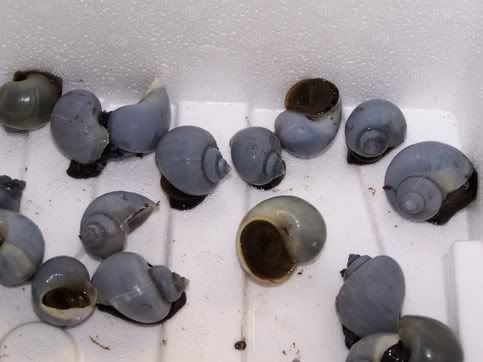| temperature: |
70ºF to 86ºF (21-30°C) Optimum 76ºF (24°C) |
Live adult blue Mystery snails ! Don't buy babies for a crazy price, buy adults for cheap ! The pictures are our actual snails, wonderful shells. Snails will arrive safe through express mail, ice pack and plenty of support so they don't bounce around.
Mystery Snails

Our Blue Mystery Snails On 08/31/06.
Survive in aquariums: Yes
Survive in warm ponds: Yes
Survive in cold ponds: No
Plant eating capacity: Low to High (varies with species)
Algae eating capacity: Moderate to High
Breathing: Gilled
Breeding: Sexual, egg-laying; some people say that some are live-bearing
Mystery snails are medium-sized tropical snails. Some mystery snails are Ampullaria
sp. such as the four horned and Golden Inca snails above which are heavy algae and plant
eaters. Another keeper of apple and mystery snails says that all mystery snails are the apple snail,
Pomacea bridgesii (usually written incorrectly as Pomacea bridgesi).
Yet another source says they are all Pomacea cuprina! The guy who runs
applesnail.net says most mystery snails are Pomacea bridgesii or from the
Viviparidae family. I have seen snails sold as mystery snails that are all different
colors and obviously multiple species. There is no agreement between stores, keepers, and
"experts" as to what is what. Some mystery snails eat algae and detritus and do not overly harm
plants. Since they must be kept above 70 degrees F at all times, they cannot be kept in ponds
except in tropical regions. They make a good heated aquarium snail. Males may have a convex
(sticks out) operculum or trap door, and females may have a concave (goes in)
operculum. Mystery snails may "play dead" for days or even weeks by floating on the surface or
laying still on the bottom . The
reason for this dormancy is unknown. Most commonly sold mystery snails are also apple snails.
Apple and mystery snails are often interchanged. This is confusing to many people.The mystery snail truly is a mystery because it can refer to dozens of possible species with totally
different attributes. No "experts" seem to agree on what is what!
$3.00 Each !
Other information from us that you might be interested in:

Other Exotic Wet Pets !!! Check them out -
Shipping & Payment Please read !
Anoles / Lizards For Sale
Green Tree Frogs and Other Frogs/Toads

Email: info@exoticwetpets.com


